Everything you need to know about cactus dahlias
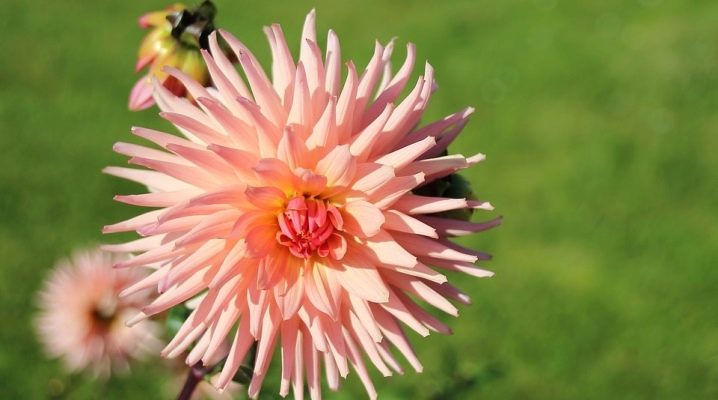
Cactus dahlias are considered a real decoration of any garden - this is a bright, spectacular and at the same time very delicate plant. However, in order for it to delight you with its flowering as long as possible, you should know some of the intricacies of caring for dahlias.
Characteristic
Cactus dahlias are perennials. The height of an adult bush varies from 30 to 150 cm, in floriculture it is used both in a potted version and in open ground. The main advantage of cactus dahlias is the duration of flowering - you can enjoy their decorative beauty from the first days of summer until the end of October.
The plant is presented in a wide variety of species - there are mono- and multi-colored varieties, tall and short. Dahlias are planted in flowerpots, grown in a flower bed, or placed right between the beds. Flowers of this type get along well with many other vegetable and flower crops, therefore, no problems with the neighborhood usually arise.

The diameter of the flowers varies from 5 to 30 cm. They are presented in a variety of shades, the abundance of colors is truly amazing - here you can find any colors except blue, black and brown. There is perhaps only one drawback of these representatives of garden flora - in the fall, you have to devote some time to preparing the tubers for wintering. Only with the observance of the technology for preserving planting material can one hope to get a flower bed of incredible beauty.
It is interesting! Few people know that cactus dahlias were originally grown for edible tubers. Only after many decades in Europe they began to be widely used in gardening.
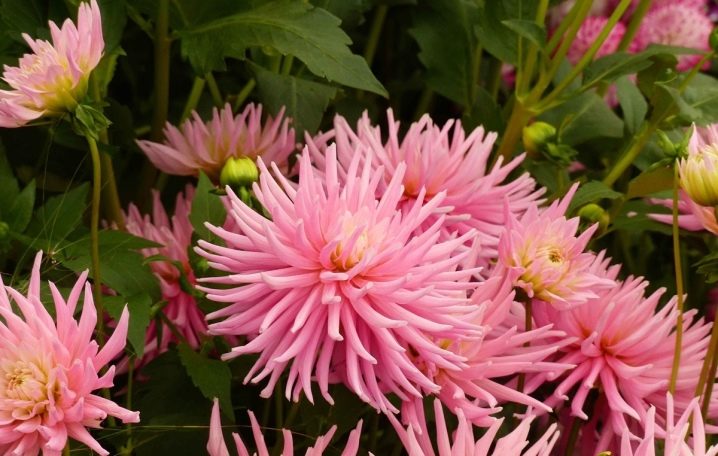
Varieties
The most popular varieties of cactus dahlias include the following.
- "Snoho Diana" - a very beautiful decorative flower, the height of the bush reaches 1.3 m, each gives about 10 flowers.

- "Ferdiff illusion" - each bush produces 3-4 very lush flowers that invariably attract attention.
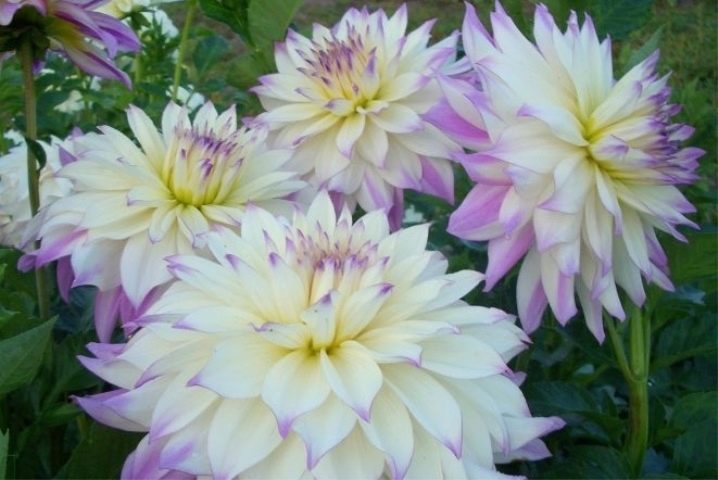
- "Summer night" - a colorful plant with rich scarlet petals, considered a real flower bed decoration.
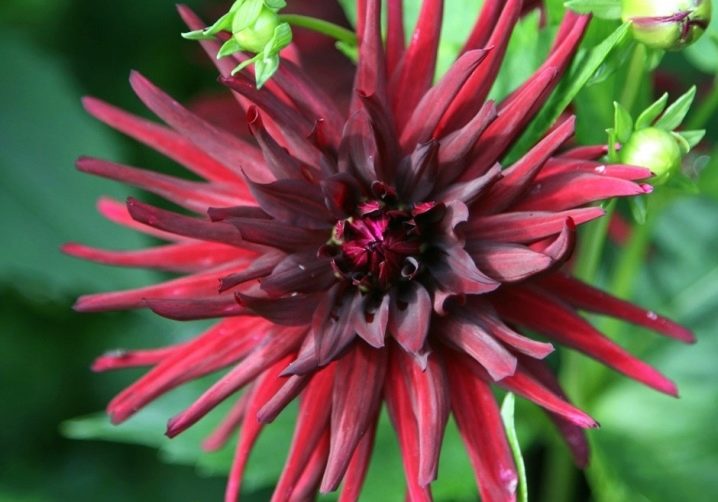
- "Kiruna" - a rather unusual variety, which is distinguished by real luxury and nobility. This is a two-tone dahlia, with one tone smoothly passing into another, forming truly luxurious buds.

- "Shooting Star" - tall, large flowers, lemon-colored, purple edging around the edges. Visually resemble decorative chrysanthemums.
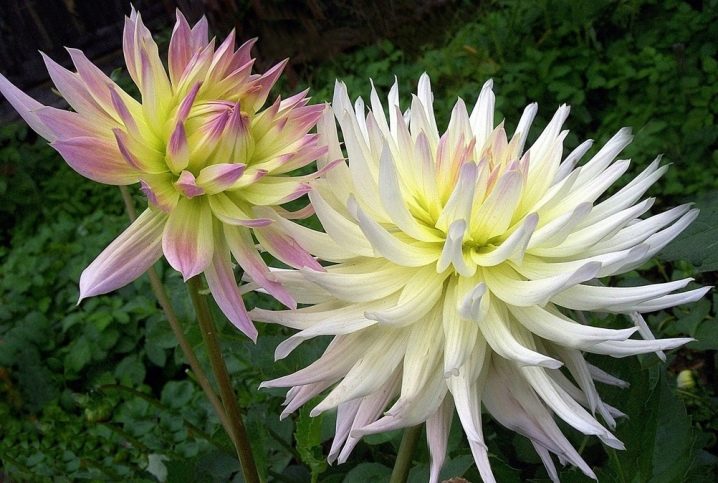
- "Grand final" - a flower growing up to 1.4 m, the petals are usually whitish or red.
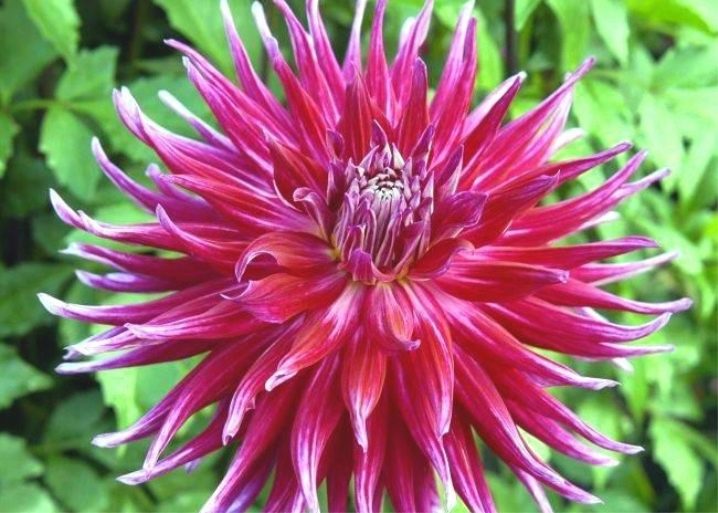
- "Lilaste Seren" - unusual flowers of a pleasant lilac color. The bush is quite compact, the leaves are delicate.
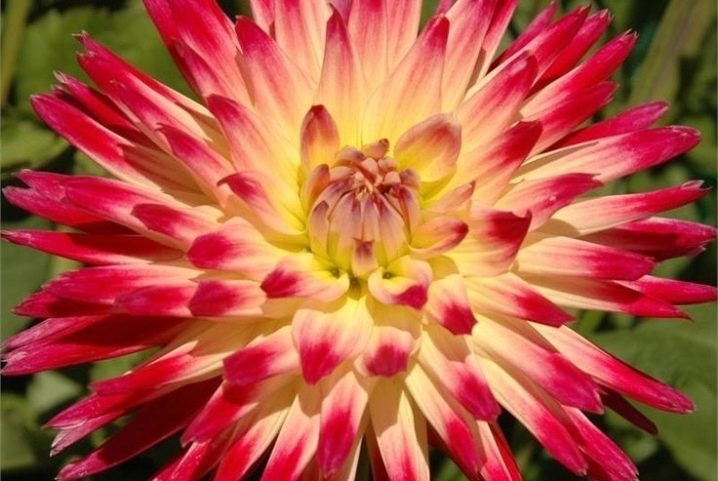
- "Citric" - one of the largest plants, which in favorable conditions can grow up to 2 m, petals are light yellow.
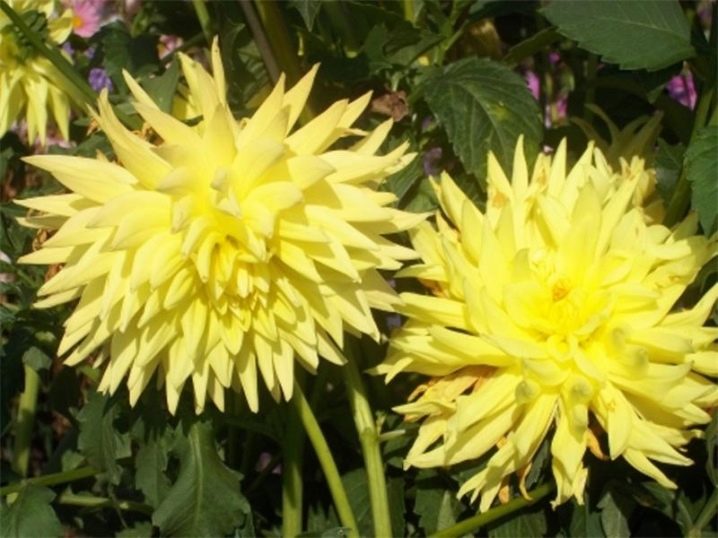
- "Cherio" - bright red dahlias with white edging on each petal. The inflorescences are quite large - each up to 15-16 cm in diameter, the plant height is 1.2-1.3 m.
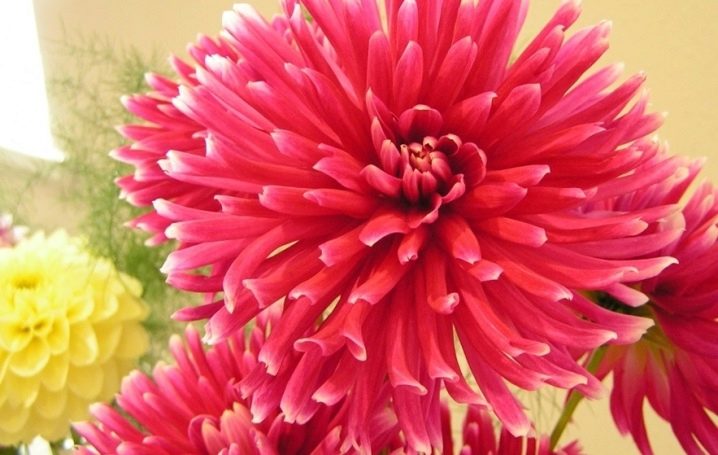
- Acapulco - a tall plant up to 1.5-1.7 in length, crimson flowers, slightly scattered petals, collected in small inflorescences.
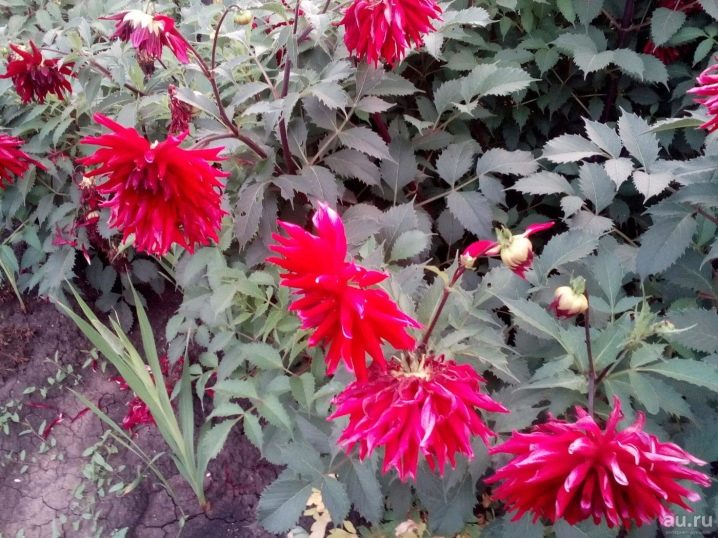
- Anderson - very delicate dahlias that can become a real flower bed decoration and are in perfect harmony with many other garden crops.
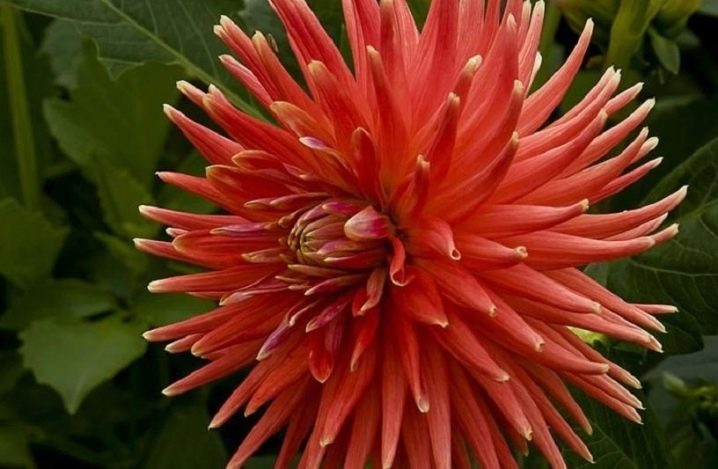
- "Aloha" - bushes grow up to 1.5 m, flowers reach 18-20 cm, about 10 flowers can be cut from each plant.
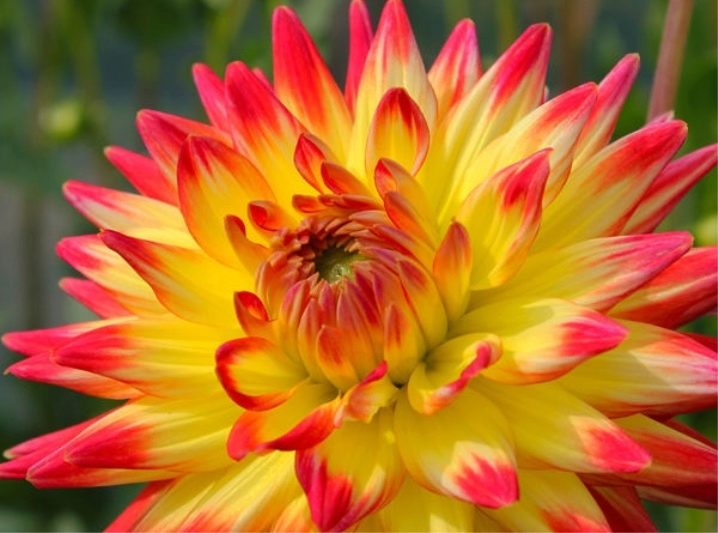
- "Volcano" - one plant gives about 6 flowers, the height of the bush reaches 1.4 m, the petals are bright red, under the influence of direct sunlight, they change color to orange.
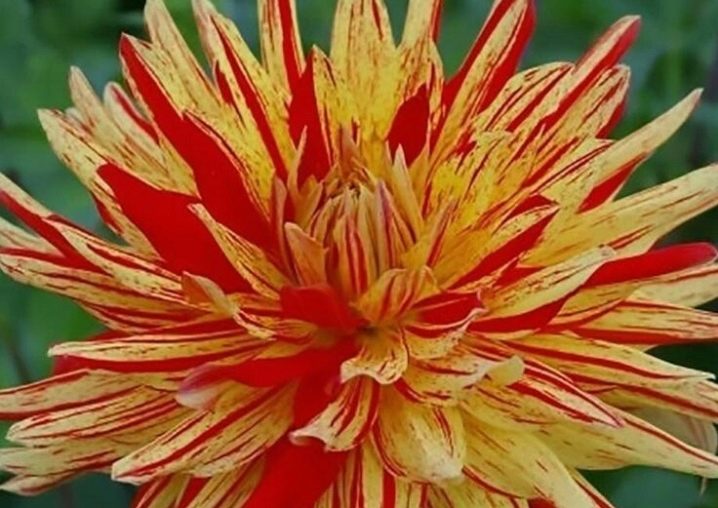
- "Dream" - the plant produces up to 20 bright decorative flowers. Height - about 1.3 m.

- "Red clove" - a bush about 1.3 m long, the color of the petals changes in the sun;

- "Dana" - flowers about 110 cm high stand out with unusual petals that roll into tubes.
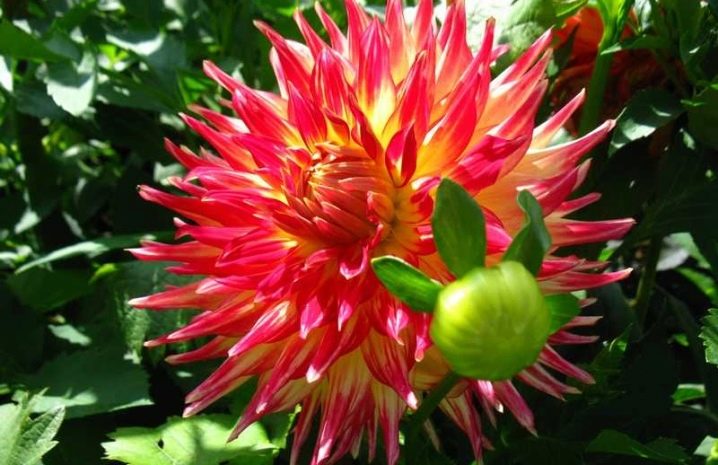
In gardening, varieties are also very popular Princesses Park, Flowered Mix, Freakwolet, Blackberry Ripple, as well as Weston Spenish Dancer, Ash Jam, Fiesta, Tahiti Sunrise.
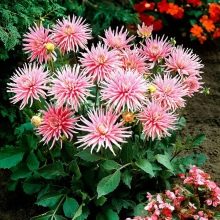
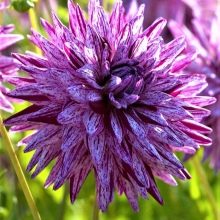
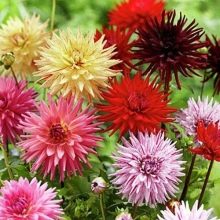
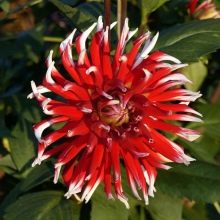

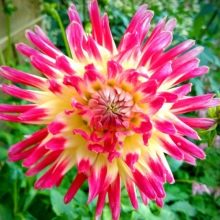
Landing
Dahlias are very demanding on living conditions, therefore, when planting plants, you should be especially careful when choosing a site for a future flower bed. These plants prefer warm and well-lit areas. For full growth and flowering, plants must be exposed to sunlight for at least 7-8 hours a day. The place should be not darkened, but at the same time protected from strong winds and drafts.
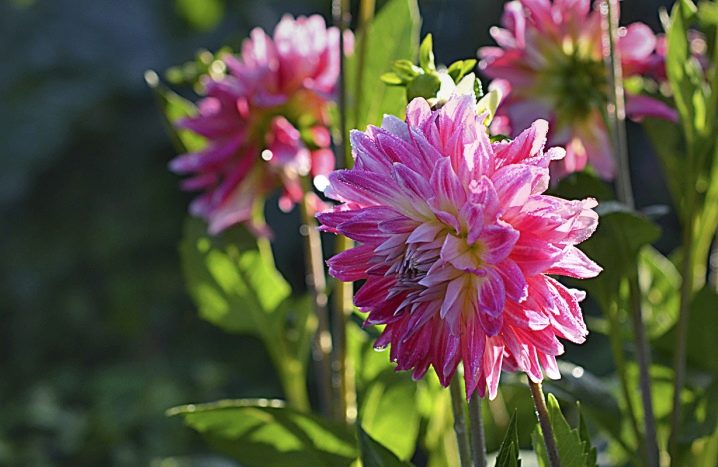
For propagation of cactus dahlias by seed method planting work should begin in March. In this case, the seeds are planted in a substrate consisting of peat and sand, lightly sprinkled, moistened with a drip method and covered with a film to create the effect of a mini-greenhouse. The greenhouse follows ventilate and water daily, as soon as shoots appear, the film can be gradually removed.
Flowers are transplanted into open ground in early summer.
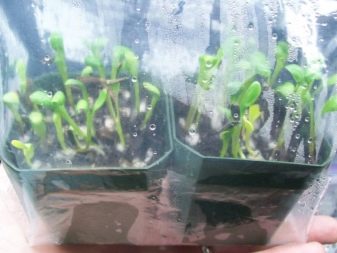

Dahlias can be planted with tubers. To do this, in April, the rhizomes are placed in a mixture of peat with sand or wet sawdust, providing sufficient light. As soon as the buds appear, it is necessary to immediately divide the tuber into 2-4 parts so that each has its own bud, after which the tubers are kept in the soil mixture until May. When the threat of return spring frosts has passed, they choose healthy planting material without visible damage and proceed directly to planting.
Planting holes are made with a depth of 15-20 cm, with a step of 50-70 cm, depending on the variety series. If you plant tall dahlias, the distance between the bushes should be greater.
Additionally, a support may be required - it must be installed immediately, and if you do this after germination, then there is a high probability of damaging the rhizomes. The tubers are placed in the recess with their eyes downward, covered with earth, watered and mulched.
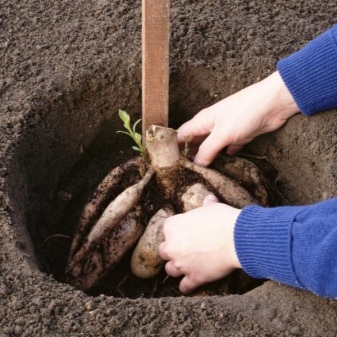
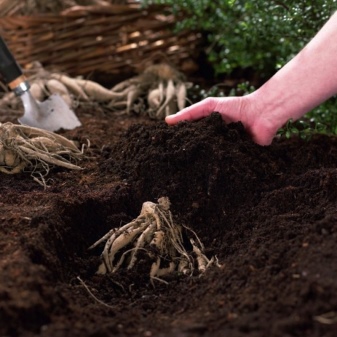
The method of planting by cuttings is no less popular. To obtain them, in the first half of March, the tubers are placed in wet compost and await the emergence of shoots. As soon as they grow 7-10 cm, you need to carefully cut them and send them to the container for rooting. During this period, the plant needs good watering, if necessary, you can use drugs that stimulate root formation, for example, Kornevin. In May, the cutting is transplanted into an open area along with an earthen lump.
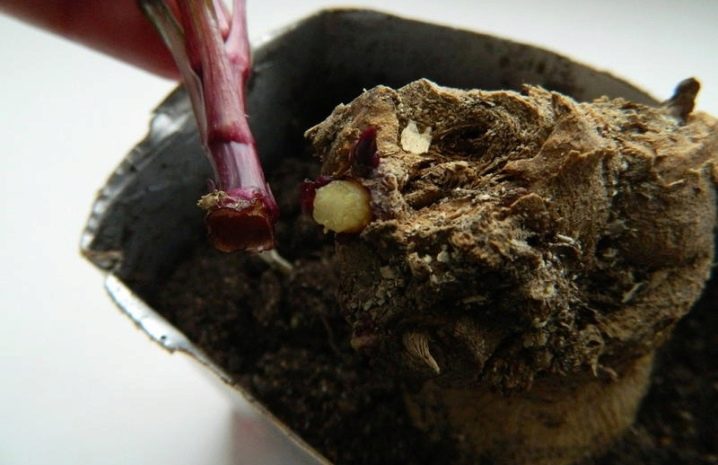
Care
In order for dahlias to fully grow and delight gardeners with their long and abundant flowering, plants need proper care: regular watering, weeding, loosening the soil, fertilizing, tying to the support posts and pinching.
Watering and feeding
When growing dahlias, the soil should not be allowed to dry out; watering should be regular. It is advisable to make it using special nozzles on the hose - sprayers. However, do not flood the flower, as waterlogging of the soil leads to rotting of the roots and the death of the entire bush.
Top dressing is carried out every 10-15 days, they must be applied after watering. To do this, a small depression of 7-10 cm is created near the bush, watered with a nutrient solution and a groove is buried.The first feeding is carried out a week after planting in open ground, it is best at this moment to use ready-made store preparations for decorative flowering plants.
In June and the first half of July, it is better to use mullein infusion, diluted in a ratio of 1: 10, with the addition of products containing nitrogen and phosphorus (10 g of each drug per bucket of water). In August, 3-4 handfuls of ash are introduced, as well as superphosphate at the rate of 30 g for each bush. From the first days of September, the plant should be fed with potassium sulfate (30 g per plant) - it stimulates the ripening of tubers.
During this period, it is worth excluding nitrogen compounds - they only cause the growth of vegetative green mass, in this case the tubers will be very poorly stored. From the second half of September, feeding should be stopped.
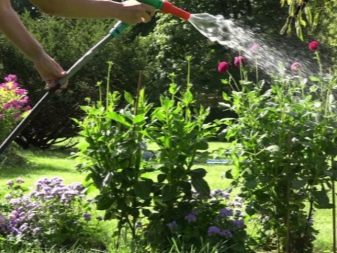

Garter
When the plant grows up to 30-40 cm, it is necessary to tie it to a support. If this stage is neglected, then the plant is threatened with breaking off and a significant decrease in decorativeness.

Stepping
The lateral branches of dahlias must be regularly trimmed in the early stages of growth - this not only makes the bush more harmonious, but also stimulates earlier flowering. With the appearance of the fourth pair of leaves, pruning is suspended, but you can pinch the main shoot over this pair - in this case, the number of inflorescences for cutting will be greater. Low-growing varieties do not require pinching.

Wintering
Shortly before the onset of frost, the tubers must be dug out of the ground - this is usually done in the first half of October. Rhizomes are stored in a cool room at a temperature of 5-7 degrees and a humidity of 75-80%.
For the preservation of all vegetative properties, it is necessary to place the planting material in sand or peat.

Pests and diseases
Dahlias often fall prey to various diseases, the most common of which are viral mosaics and bacterial cancer. TO Unfortunately, these diseases are practically not cured, so diseased dahlias will have to be discarded, dug up with the root and burned. Powdery mildew also often affects cactus dahlias - flower diseases can be cured by spraying with a solution of laundry soap, followed by treatment with copper sulfate.
Among insect pests, the most dangerous are aphids, spider mites and caterpillars. It is best to use a broad spectrum insecticide. Also, insects are often frightened off by the smell of marigolds, so it is very useful to plant them next to dahlias. In addition, these crops are perfectly combined in the same flower bed.


Use in landscape design
The cactus dahlia variety is a favorite of landscape designers. This is not surprising, given the beauty and decorativeness of the plants. They can be planted in small groups or individually, grown as part of a rabatka or placed in tubs.
Flowers look no less impressive as a background for herbaceous perennials, in addition, dahlias planted along the illuminated side of the building can be an excellent decor for a nondescript wall of any garden structure.

For information on how to properly grow a cactus dahlia, see the next video.







































































































The comment was sent successfully.